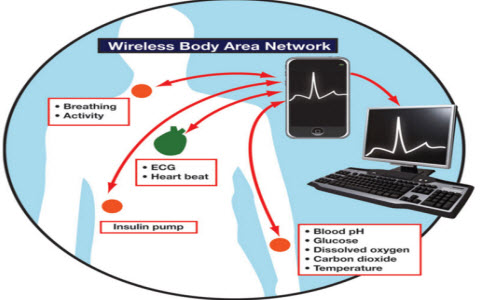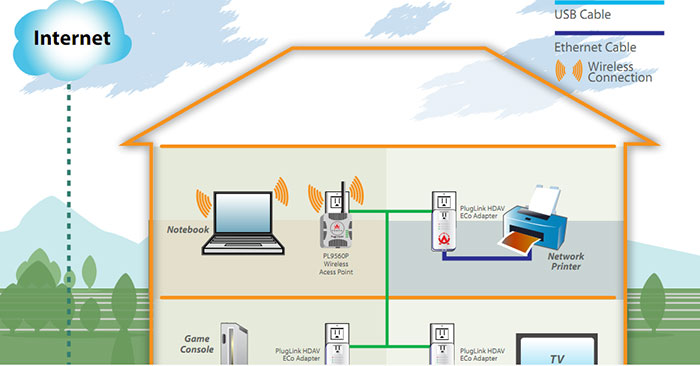What is WBAN (Wireless Body Area Network)?
In today's world, wireless communication has a major application in sharing information anytime, anywhere. Users can use wireless networks in the form of WLAN or WiFi in many different fields, such as education, healthcare and industry.
As the technology develops, the user's need for network connectivity is increasing. WBAN (Wireless Body Area Network) allows users to move to another place without being restricted with cables to share information.
What is WBAN network?

WBAN is a network of sensor nodes attached to the human body
The term 'Wireless Body Area Network' was coined in 2001 by Van Dam. It is essentially a network of sensor nodes attached to the human body, used to measure human biological signals (heart rate, blood pressure, brain signals, etc.). . This network is mostly used in applications in the medical field.
There are 2 types of communication in body sensor networks:
- In-body communication
- On-body communication
Intra-body communication is the communication between sensor nodes implanted inside the human body. Medical Implant Communication System (MICS) can only be used for internal communication. Body communication that occurs between wearable devices includes sensor buttons. The ISM (Industrial Scientific and Medical) band and UWB (Ultra-wide band) communication can only be used for body communication.
Requirements of the WBAN network
- Low power consumption
- Interactive abillity
- Self-healing
- Security
- Low latency
WBAN network structure
The network structure is divided into 4 parts:

1. WBAN section
It contains several low-cost and low-power sensor buttons, which can be used to continuously monitor a person's heart rate, ECG, blood pressure, etc. The essence is wireless, this does not limit the human ability to move for continuous evaluation. Therefore, WBAN is used in healthcare systems to monitor patients.
2. CCU (Central Control Unit)
All sensor buttons that provide output to a central coordinator are found in the CCU. The CCU receives the signal from the nodes and transmits it to the next section to monitor the human body.
3. WBAN communication
Receives information from the CCU and acts as a gateway to pass the information to the destination. For example, the cell node is a gateway to the remote station for sending messages to cellular networks using GSM / 3G / 4G.
4. Control Center
It is responsible for storing the user's information that can be used in the future or for monitoring purposes. This section covers endpoint devices such as cell phones (for texting), computer systems (for monitoring), and servers (for storing information in a database).
The WBAN applications
These are the different applications of the WBAN network:
1. Medical application

Remote healthcare monitoring - Sensors are placed on the patient's body to monitor heart rate, blood pressure and electrocardiogram.
Telemedicine - Providing long-distance healthcare services with the help of IT and communication.
2. Non-medical application
Sports - Sensors can be used to measure navigation, timer, distance, heart rate and body temperature.
Army - Can be used to communicate between soldiers and send information about an attack, retreat or run to command.
Life and entertainment - Wireless music player and video calling.
WBAN is legal, affordable, and user-friendly. This is an emerging technology and is expected to have a major impact on society.
You should read it
- What is Near-me Area Network (NAN)?
- Learn about Home Area Network (HAN)
- Learn about basic WLAN devices
- GAN (Global Area Network) price, marketcap, chart, and fundamentals info
- Learn about Wireless Sensor Network (WSN)
- Six steps for wireless network location survey
- Learn SSID and wireless network
- Desk Area Network (DAN)
- Basic guide: wireless network - Wireless
- Wide area network WAN - Next part
- Basically about Wireless Networking
- Learn about local area network - LAN (Part I)






 What is Near-me Area Network (NAN)?
What is Near-me Area Network (NAN)? Learn about basic WLAN devices
Learn about basic WLAN devices Six steps for wireless network location survey
Six steps for wireless network location survey Learn about Home Area Network (HAN)
Learn about Home Area Network (HAN) GAN (Global Area Network) price, marketcap, chart, and fundamentals info
GAN (Global Area Network) price, marketcap, chart, and fundamentals info Learn about Wireless Sensor Network (WSN)
Learn about Wireless Sensor Network (WSN)